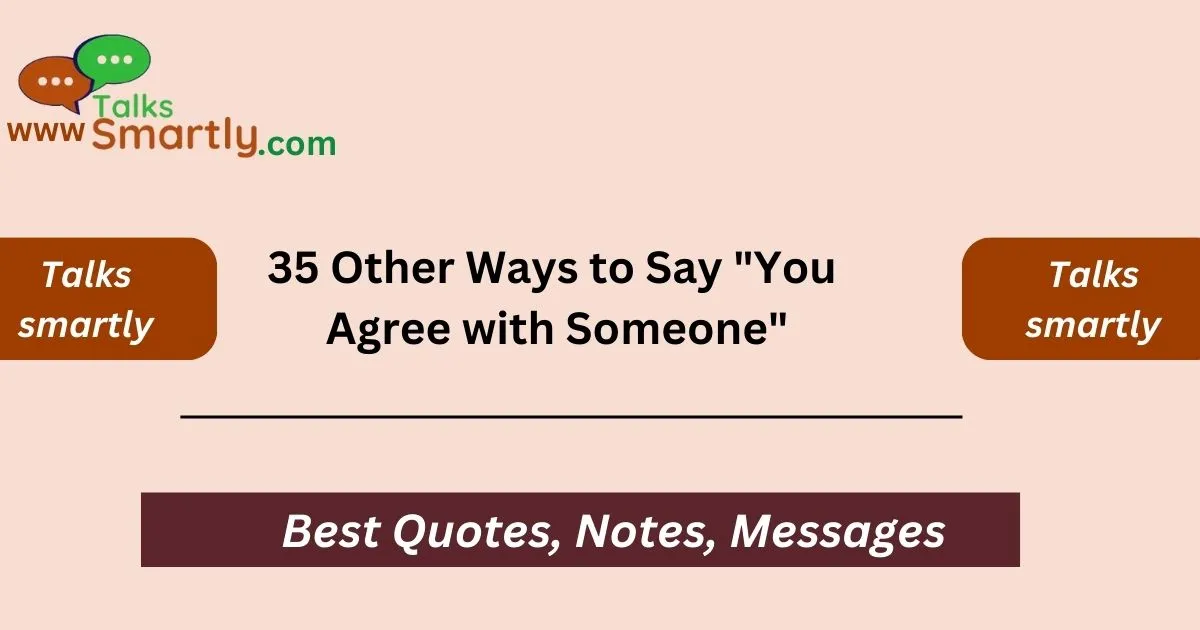Finding the right words to express agreement can elevate your conversations and make them more engaging.
In conversations, we often find ourselves needing to express agreement with someone’s thoughts or ideas. While saying “I agree” is straightforward, repeating it too often can make interactions feel monotonous. Learning alternative phrases can enrich your vocabulary, make your communication more engaging, and showcase your personality.
Are you ready to take your conversations to the next level? This blog post will equip you with 35 creative and meaningful ways to express agreement with someone. Bookmark this list and practice these phrases to refine your conversation skills.
Expressing agreement in different ways adds depth to your conversations, helps build rapport, and makes your communication memorable. Whether you’re talking casually with friends, participating in a formal discussion, or replying in professional settings, these phrases will come in handy.
35 Ways to Say “You Agree with Someone”:
- Absolutely, I agree!
- I couldn’t agree more.
- You’re absolutely right.
- That’s exactly how I feel.
- We’re on the same page.
- Spot on!
- That’s true.
- You nailed it.
- I feel the same way.
- Couldn’t have said it better myself.
- I’m with you on that.
- No doubt about it.
- That’s a good point.
- I see where you’re coming from.
- Exactly!
- That’s right.
- You’ve got a point there.
- I think so too.
- Fair enough.
- That’s my thought too.
- I completely agree.
- So true!
- You’re right on the money.
- Couldn’t agree more.
- We’re aligned on this.
- It’s hard to argue with that.
- Yes, absolutely.
- I share your view.
- That’s my perspective too.
- Couldn’t have put it better myself.
- You make a valid point.
- I’m in total agreement.
- Without a doubt.
- You’re spot-on.
- I second that.
1. Absolutely, I agree!
This phrase conveys full confidence in your agreement, often used to express enthusiasm.
Example:
A: “The new café in town has amazing coffee.”
B: “Absolutely, I agree! Their lattes are the best.”
2. I couldn’t agree more.
Indicates complete alignment with someone’s statement, leaving no room for doubt.
Example:
A: “Family is the most important thing in life.”
B: “I couldn’t agree more. They’re everything.”
3. You’re absolutely right.
A polite and direct acknowledgment of someone’s correctness or insight.
Example:
A: “We need to focus on customer satisfaction.”
B: “You’re absolutely right. It’s key to growth.”
4. That’s exactly how I feel.
Highlights a shared emotional or intellectual alignment with the speaker.
Example:
A: “This movie really speaks to the struggles of modern life.”
B: “That’s exactly how I feel. It’s so relatable.”
5. We’re on the same page.
Expresses mutual understanding and a shared perspective or goal.
Example:
A: “Let’s finalize the designs before Friday.”
B: “We’re on the same page. I’ll get it done.”
6. Spot on!
A casual and concise way to affirm someone’s accuracy.
Example:
A: “This strategy will improve our efficiency.”
B: “Spot on! It’s exactly what we need.”
7. That’s true.
A simple acknowledgment of a fact or valid opinion.
Example:
A: “This neighborhood is really peaceful.”
B: “That’s true. It’s perfect for families.”
8. You nailed it.
A fun and enthusiastic way to agree with someone’s insight or achievement.
Example:
A: “The key to a good presentation is confidence.”
B: “You nailed it. That’s what makes it impactful.”
9. I feel the same way.
Shows a shared emotional or intellectual connection.
Example:
A: “This song always lifts my mood.”
B: “I feel the same way. It’s so uplifting.”
10. Couldn’t have said it better myself.
Acknowledges that the speaker has perfectly captured your thoughts.
Example:
A: “Respect is crucial in any relationship.”
B: “Couldn’t have said it better myself.”
11. I’m with you on that.
Shows solidarity and agreement with someone’s viewpoint.
Example:
A: “We should prioritize health over deadlines.”
B: “I’m with you on that.”
12. No doubt about it.
Expresses absolute certainty in agreement.
Example:
A: “This city has the best street food.”
B: “No doubt about it. It’s unbeatable.”
13. That’s a good point.
Acknowledges the validity of someone’s statement or argument.
Example:
A: “Reducing screen time can improve focus.”
B: “That’s a good point. I should try it.”
14. I see where you’re coming from.
Shows empathy and understanding of someone’s perspective.
Example:
A: “Balancing work and family is challenging.”
B: “I see where you’re coming from. It’s not easy.”
15. Exactly!
A short and emphatic way to agree, often used in casual settings.
Example:
A: “Honesty is always the best policy.”
B: “Exactly!”
16. That’s right.
A straightforward affirmation of someone’s correctness.
Example:
A: “Exercise helps boost mental health.”
B: “That’s right. It’s scientifically proven.”
17. You’ve got a point there.
Recognizes a valid perspective in someone’s argument.
Example:
A: “Taking breaks can enhance productivity.”
B: “You’ve got a point there.”
18. I think so too.
A casual agreement with someone’s opinion or idea.
Example:
A: “This restaurant serves great pasta.”
B: “I think so too.”
19. Fair enough.
Acknowledges that the other person’s point of view is reasonable.
Example:
A: “Let’s split the work evenly.”
B: “Fair enough. That sounds fair.”
20. That’s my thought too.
Shows that you share the same opinion or perspective.
Example:
A: “We should invest more in renewable energy.”
B: “That’s my thought too.”
21. I completely agree.
Demonstrates total agreement with someone’s opinion.
Example:
A: “Education is the key to success.”
B: “I completely agree.”
22. So true!
A light and casual way to affirm someone’s statement.
Example:
A: “Laughter is the best medicine.”
B: “So true!”
23. You’re right on the money.
Acknowledges someone’s precise and accurate statement.
Example:
A: “Time management is crucial for success.”
B: “You’re right on the money.”
24. Couldn’t agree more.
A concise way to show complete alignment with someone.
Example:
A: “Teamwork makes the dream work.”
B: “Couldn’t agree more.”
25. We’re aligned on this.
Shows that you and the other person share the same viewpoint or strategy.
Example:
A: “We need a more sustainable approach.”
B: “We’re aligned on this.”
26. It’s hard to argue with that.
Acknowledge that someone’s point is indisputable.
Example:
A: “Health should always come first.”
B: “It’s hard to argue with that.”
27. Yes, absolutely.
A polite and enthusiastic way to confirm agreement.
Example:
A: “We should celebrate this milestone.”
B: “Yes, absolutely.”
28. I share your view.
Indicates a shared perspective or opinion.
Example:
A: “Reducing waste is everyone’s responsibility.”
B: “I share your view completely.”
29. That’s my perspective too.
Reinforces a shared outlook on a subject.
Example:
A: “Innovation drives progress.”
B: “That’s my perspective too.”
30. Couldn’t have put it better myself.
Acknowledges that the other person’s phrasing was perfect.
Example:
A: “Kindness goes a long way in building relationships.”
B: “Couldn’t have put it better myself.”
31. You make a valid point.
Appreciates the logic or validity in someone’s argument.
Example:
A: “We should allocate more resources to this project.”
B: “You make a valid point.”
32. I’m in total agreement.
Indicates complete and unwavering alignment with someone.
Example:
A: “Employee well-being should be a top priority.”
B: “I’m in total agreement.”
33. Without a doubt.
Expresses certainty in agreeing with someone.
Example:
A: “This city has the best sunsets.”
B: “Without a doubt.”
34. You’re spot-on.
Acknowledges someone’s accuracy or insight.
Example:
A: “Preparation is key to success.”
B: “You’re spot-on.”
35. I second that.
A phrase often used in formal discussions to show support or agreement.
Example:
A: “Let’s organize a team-building event.”
B: “I second that idea!”
Key Insight
1. Why is it important to use different ways to agree with someone?
Using varied phrases makes your communication more engaging and demonstrates thoughtfulness in your responses.
2. Can these phrases be used in formal and informal settings?
Yes, many of these phrases work across both settings. Be mindful of the tone and context.
3. How can I practice using these phrases?
Start incorporating one or two phrases daily in your conversations and observe the reaction from others.
4. Which phrases are best for professional discussions?
Phrases like “You make a valid point” or “I’m in total agreement” are suitable for formal settings.
5. Can these phrases help in conflict resolution?
Absolutely! They show that you’re actively listening and respecting the other person’s perspective, which fosters harmony.
Conclusion
Mastering various ways to say “I agree” can transform your communication style, making your conversations more engaging and professional. From casual chats to formal meetings, these 35 phrases are tools to express agreement creatively and effectively. Practice them daily, and watch your conversational skills shine!










